
After arriving there we found the harbour brimful of ships. Large freighters, a couple of small passenger ships and a number of Navy vessels of differing nationalities. This time no anchorage a long way from the action but right on the wharf. This typified the distressed situation very well. Without delay the hatches were opened and in great haste the ammunition was being unloaded.
At the same time a gang of workers came aboard who, clearly in great haste, started to build a long row of latrines along the railing above a wide gutter which led overboard. In addition they brought kitchen materials and food on board.It was not long before we were told what we could expect. We were being prepared as an evacuation ship for the personnel of the forces. Members of the Army, Airforce and Navy of many different nations were to be ferried to Australia. We thought: ‘You need an entire fleet for this’ and could not wait to see it.
In the meantime we saw ships coming and going. The departing ships loaded to the hilt with refugees. One day all Navy vessels which were in the harbour left. Later we found out they had sailed to the Java Sea where on 28th February and 1st March they did battle with the Japanese fleet and suffered severe losses.
On 27th February, the day before the battle, all the ships in the harbour were ordered to leave for either Ceylon or Australia by evening. This created a great urgency, not only for the people unloading the ammunition but even more so for the refugees who were still on the way to our ship.The unloading of the ammo was stopped. We found that the bottom holds were still loaded to the top. The hatches could just be closed without divulging what was underneath.
During the day the men came aboard. A more diverse lot I have never seen. Aircraft crews still wearing their thick woollen jackets, a few high and a lot more lower officers, soldiers and sailors, both with and without weapons, and then some civilians, many with worried and tired faces. Well what can you expect? Most had left family behind and all faced a dangerous and uncertain future. They were spread over the entire length of the ship as well as in the top holds; everybody was given a camp bed. For most it was not easy. They had to leave, unprepared and hastily, very familiar surroundings and were literally plonked into the hold of a freighter, not a particularly well placed area to escape from in case of an emergency.
 And so we went at a snail,s pace. On that same day a total of 24 big and small ships amongst which were the ‘Zaandam’ and the ‘Jagersfontein’ departed from the Tjilatjap harbour with the knowledge that the sea between them and their destination was infiltrated with Japanese warships, aircraft carriers and many submarines. The Captains had to decide their own course to steer and in the engineroom the engines were stretched to the limit. None of the passengers knew that in the bottom hold there were a couple of thousand tons of ammunition. I believe that every member of the crew found it better not to speak about it and as far as I know we did not speak about the unbelievable number of ‘S.O.S’ signals we received from ships sailing in our vicinity. All were about attacks from surface ships and submarines. We asked ourselves; ‘Will this mess never end?’
And so we went at a snail,s pace. On that same day a total of 24 big and small ships amongst which were the ‘Zaandam’ and the ‘Jagersfontein’ departed from the Tjilatjap harbour with the knowledge that the sea between them and their destination was infiltrated with Japanese warships, aircraft carriers and many submarines. The Captains had to decide their own course to steer and in the engineroom the engines were stretched to the limit. None of the passengers knew that in the bottom hold there were a couple of thousand tons of ammunition. I believe that every member of the crew found it better not to speak about it and as far as I know we did not speak about the unbelievable number of ‘S.O.S’ signals we received from ships sailing in our vicinity. All were about attacks from surface ships and submarines. We asked ourselves; ‘Will this mess never end?’
More than ever I realized that working in the engine room during wartime one never got used to the fact that you could hear or see nothing of what was happening outside. Particularly if you were aware that not too far away somebody could be ready to push a button to release a bomb, torpedo or grenade at your ship. After one’s watch going topside you could still be blown up every second during the day or night. Nevertheless I was happy every time I finished my watch. It was difficult to be happy thinking about our cargo; I thought everybody was of the same opinion.
A day later we got a diversion in the form of a Japanese single engine aircraft, which quite clearly was observing us and sending our position to the closest warship or aircraft carrier. What a pity that we did not have our anti-aircraft guns anymore. All the people on board were now on deck. They were shooting with rifles and even handguns: A lot of noise but of course no results. The aircraft turned and disappeared, not because of the firing but because the pilot had seen enough.
 What to do now? From the bridge we were asked to get a little more speed from the engines, which we did. At sundown the Captain ordered a substantial change in direction. At sun up the following morning the bow of the ship was still slicing through the water at full speed. This and the knowledge that we had covered a good many miles gave us renewed hope. Of course there could be no certainty because ‘S.O.S’ signals were still coming in regularly.
What to do now? From the bridge we were asked to get a little more speed from the engines, which we did. At sundown the Captain ordered a substantial change in direction. At sun up the following morning the bow of the ship was still slicing through the water at full speed. This and the knowledge that we had covered a good many miles gave us renewed hope. Of course there could be no certainty because ‘S.O.S’ signals were still coming in regularly.
And so we safely reached Australia and the harbour of Perth, called Fremantle.
<< previous chapter —————————————————————––next chapter >>

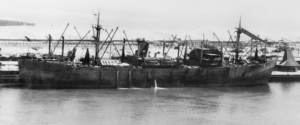
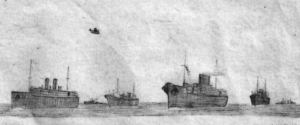
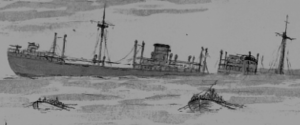
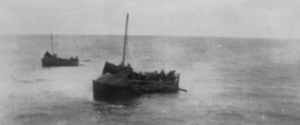
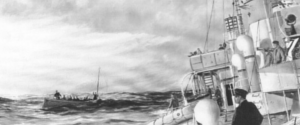
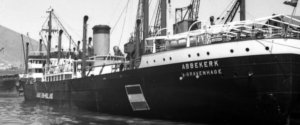




My grandfathers ship was one of those sending out an SOS. Never seen or heard of again until remains dug up from mass grave at Kendari, Celebes in 1946. All decapitated. He ship was the MS Modjokerto sunk on the 1st of March.
My father escaped on the Cote Gede too.
Saya lahir di cilacap,th.1954.sampai dengan th.tujuhpuluhan masih banyak bangkai kapal berserakan.sekarang sekali sudah dibersihkan untuk pengembangan pelabuhan
My grandparents were aboard a Dutch vessel departing Tjilatjap on March 1 1942. Boarded in the afternoon and left port in the evening. They arrived Freemantle Saturday March 7th. According to a letter my grandfather wrote, the ship was a liner formerly on the transatlantic run. He described it as normally accommodating 150 passengers but carrying significantly more people leaving Tjilatjap. Quite possibly the MS Zaandam.
Kheon Hoea (departed Tjilatjap 1 March 1942, arr Fremantle 7 March
MV Zaandam (departed Tjilatjap 1 March 1942 arr Fremantle 7 March
Generaal Verspyck (departed Tjilatjap 2 March 1942 arr Fremantle
SS Tung SOng (departed Tjilatjap dusk 2 March 1942 arrived Fremantle 13 March).
MV Janssens (departed Tjilatjap 4 March, arrived Fremantle 13 March).
Ian, my mother’s nephew and his parents would be evacuated via Tjilatjap. When they arrived in the harbour, they had something to eat next to the ship. During this ‘lunch’ their ship was bombed in the harbour with all their posessions on board. They had to walk back via the train-track.
Could anybody shred a light on what vessel this could have been? I would be very thankful!
Gerrit Bon.
I was in the R.A.F. and boarded the Dutch vessel Kota Gede at Tjilatjap at 5am on Feb 27 41. We waited all day and left the harbour at 8 pm. The captain steered a S.W. course and then altered course for Colombo Ceylon.
I think we were the last ship to leave.
I have a book by Saburo Saskai, a renowned Japanese fighter pilot, he was on a mission,12 fighters and 12 Betty Bombers, to bomb Tjilatjap harbour on the 28th. He wrote we found the harbour empty all the ships had left. Ian Robinson
The plane was a Kate (Nakajima B5N) single engined bomber/torpedo plane. This Kate was on patrol from one of the carriers close by and did in fect drop a single bomb. All the guns firing from Abbekerk missed, but the pilot himself missed as wel and returned safely to his carrier.
Thank to Bill Bartsch for this confirmed information.
Peter